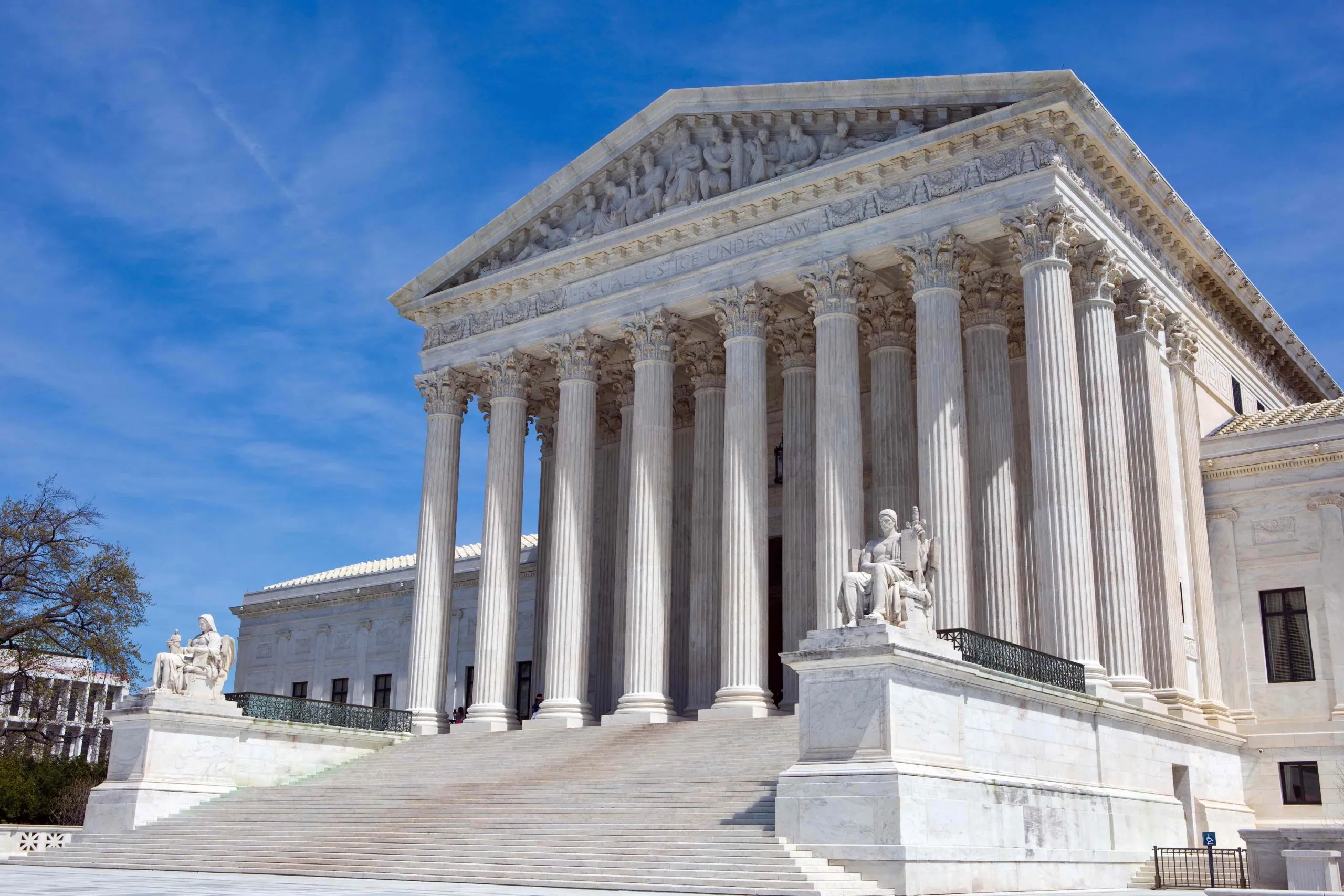Abortion access again before Supreme Court
CASE PREVIEW
on Mar 25, 2024
at 3:39 pm
Like 2022’s Dobbs v. Jackson Women’s Health Organization, Tuesday’s abortion access case comes to the justices from the Louisiana-based U.S. Court of Appeals for the 5th Circuit. (Steven Frame via Shutterstock)
Since the Supreme Court overturned the constitutional right to an abortion in 2022, 14 states have enforced total bans on abortion and seven have imposed previously unconstitutional restrictions. On Tuesday, the justices will hear arguments in a case seeking to roll back access to mifepristone, the drug used in medication abortions, which account for more than half of all abortions in the United States. The court’s ruling could affect the availability of the drug nationwide, including in the states where abortion remains legal.
The drug at the center of the case is known by the generic name mifepristone. It was first approved by the Food and Drug Administration in 2000 as part of a two-drug protocol (along with the drug misoprostol) to end pregnancies in their early stages.
When it initially approved the drug, the FDA imposed a variety of conditions on how the drug could be prescribed and used. The agency required, for example, the drug to be dispensed in person by a doctor, and only through the seventh week of pregnancy. Women taking mifepristone had to make three visits to a health-care provider: A first visit to take mifepristone; a second visit two days later to take misoprostol; and a third visit two weeks after the initial visit to confirm that the pregnancy had been terminated.
In 2016, the FDA made several changes to the conditions on the use of the drug that expanded access to mifepristone. It allowed the drug to be used through the 10th week of pregnancy, required only one in-person visit to a health-care provider, and permitted health-care providers who are not physicians to prescribe the drug.
The FDA in 2016 also eliminated the requirement for prescribers of mifepristone to report non-fatal complications (known as “adverse events”) resulting from the drug, leading to – for example – hospitalizations and blood transfusions. Mifepristone has been proven to be less dangerous than other common medications, with five deaths per million users compared to, for example, 20 and 49 deaths per million users for penicillin and Viagra.
In 2021, the FDA rolled back the in-person dispensing requirement, allowing the drug to be prescribed through telehealth appointments and sent through the mail.
Background of the case
In 2022, several individual doctors and four groups of doctors who oppose abortion on religious and moral grounds went to federal court to challenge both the initial approval of mifepristone and the 2016 and 2021 changes that expanded access to the drug. They alleged that the drug regimen was “unsafe.”
The challengers filed their lawsuit in Amarillo, Tex., where it was all but certain to be heard by Matthew Kacsmaryk, a conservative federal jurist there who, before becoming a judge, had written articles criticizing the court’s landmark decision in Roe v. Wade, establishing the constitutional right to an abortion. (The Judicial Conference of the United States, which makes policy for federal courts, recently announced a new policy intended to crack down on this type of “judge-shopping.”)
In April 2023, Kacsmaryk found that the FDA had approved the drug despite “legitimate safety concerns.” Under his ruling, the drug would not have been available at all: He suspended both the FDA’s initial approval of the drug in 2000 and its later changes to the conditions on the use of the drug.
Later that month, the Supreme Court issued a temporary order that allowed mifepristone to remain widely available while the challenge to its approvals continued. Two justices – Clarence Thomas and Samuel Alito – indicated that they would have denied the requests by the FDA and Danco, which manufactures mifepristone and joined the case to defend the drug.
Both the FDA and Danco went to the U.S. Court of Appeals for the 5th Circuit, seeking to overturn Kacsmaryk’s decision. The 5th Circuit concluded that it was too late for the doctors and medical groups to challenge the initial approval of mifepristone in 2000. But the court of appeals upheld the part of his ruling that rolled back the agency’s 2016 and 2021 actions increasing access to the drug.
The FDA and Danco came to the Supreme Court last fall, asking the justices to weigh in, which they agreed to do in December.
Whether the challengers have standing
There are three separate questions before the justices on Tuesday. The first one is whether the challengers have a legal right to sue, known as standing, at all. The FDA maintains that they do not, because the individual doctors do not prescribe mifepristone and are not obligated to do anything as a result of the FDA’s decision to allow other doctors to prescribe the drug.
The court of appeals held that the medical groups have standing because of the prospect that one of the groups’ members might have to treat women who had been prescribed mifepristone and then suffered complications – which, the FDA stresses, are “exceedingly rare” – requiring emergency care. But the correct test, the FDA and Danco maintain, is not whether the groups’ members will suffer a possible injury, but an imminent injury.
The challengers have not made that showing, the government and Danco insist. The groups suggest that their members could have to treat a patient who was prescribed mifepristone by someone else but then suffers complications requiring emergency care, and it would violate their conscience to complete her abortion. That is not the kind of imminent injury that will confer standing, the FDA writes, “because it rests on a long and speculative chain of contingencies,” and the groups cannot point to a single example of one of their members actually having to provide care in such a situation.
Danco adds that, if the Supreme Court were to rule that the challengers have standing to sue, it would allow other medical groups “to challenge virtually every government regulation that touches on health or safety.” But the implications could be even broader, Danco warns: “Teacher associations could challenge regulations they believe affect students in a way that disrupts the classroom,” or firefighters could “challenge regulations of products they say present fire risks.”
The challengers counter that the FDA and Danco’s argument that the possibility of injury is too speculative for them to have a right to sue “blinks reality.” The FDA’s plan for the distribution of mifepristone specifically contemplates that women who use the drug and have complications will have to rely on emergency care, they emphasize.
The 2016 and 2021 changes increase the likelihood that the individual challengers will have to treat pregnant women who come to the emergency room, they argue, because the elimination of the initial in-person visit (2021), the extension of the drug’s availability until 10 weeks (2016), and the elimination of the follow-up visits (2016) all increase the risk of complications. This means, the challengers reason, that “tens of thousands” of women will have to go to the emergency room, which establishes the kind of “substantial risk” that the individual doctors will have to treat such women again in the future.
The FDA’s label for the drug shows that between 0.04-0.6% of users in three studies were hospitalized after taking mifepristone and misoprostol.
Treating these women when they arrive at the emergency room results in a variety of harms for the physicians there, the challengers explain. It violates their conscience by requiring them to provide or participate in care that they “find morally and ethically objectionable.” It requires them to “divert time and resources” away from their regular practice assisting their patients with labor and delivery, and it causes them “mental, emotional, and spiritual distress” to treat patients with complications from medication abortions. Finally, it exposes them to increased liability and, as a result, to increased insurance premiums.
The challengers push back against Danco’s argument that, if their lawsuit is allowed to go forward, it will open the door for countless other challenges to regulations. That “parade of horribles does not march,” they write, because of the unique circumstances of this case. Indeed, they suggest, holding that the challengers do not have standing would “create a hole in standing jurisprudence allowing agencies to conscript third parties into fixing problems caused by their regulatory actions without affording those parties judicial recourse.”
Whether the court of appeals properly rolled back the FDA’s 2016 and 2021 changes
The second question before the justices goes to the heart of the case: Whether the 5th Circuit was correct when it rolled back the FDA’s 2016 and 2021 changes to the conditions of use for mifepristone. The debate is a technical one that focuses on the studies and evidence that the FDA considered (or allegedly failed to consider) in making its decisions to increase access to the drug in 2016 and 2021, as well as the extent to which the FDA adequately explained the reasons for those decisions.
Defending the 2016 changes, the FDA (in arguments echoed by Danco) tells the justices that the changes were both “reasonable and reasonably explained.” They “were supported by an exhaustive review of a record including dozens of scientific studies and decades of safe use of mifepristone by millions of women in the United States and around the world,” the FDA emphasizes.
The 5th Circuit’s sole reason for rolling back the 2016 changes was because it believed that the FDA should have cited a study that looked at the combined effect of all of the 2016 changes, the FDA observes. “But there is no basis for that novel requirement — and in any event, FDA did cite a study that combined the relevant changes.” Nothing in federal law required the agency to use “magic words” like “as a whole” to indicate that it had done so, the FDA asserts.
Similarly, the FDA continues, its 2021 decision to eliminate the in-person dispensing requirement rested “in part on actual experience during the pandemic,” which led it to the conclusion that it “was no longer necessary to ensure mifepristone’s safe use.”
The court of appeals rolled back this change on the ground that the sources on which the agency relied to reach this conclusion were flawed. But the federal law governing administrative agencies, the FDA says, “does not require agencies to act based on perfect data, which seldom exists. Instead, it requires them to act reasonably based on the information available” – which is precisely what the FDA did.
Danco adds that the court of appeals acted without considering all of the documents on which the FDA had relied in making the 2016 and 2021 changes. But “[e]ven the limited record that was before the lower courts, however, demonstrates that FDA’s 2016 and 2021 actions were ‘reasonable and reasonably explained,’” Danco writes.
Both the FDA and Danco caution that upholding the 5th Circuit’s ruling could have implications well beyond access to mifepristone. The FDA notes that this is the first time that any court has “restricted access to an FDA-approved drug by second-guessing FDA’s expert judgment about the conditions required to assure that drug’s safe use.”
The 5th Circuit’s analysis, Danco warns, “threatens to destabilize the pharmaceutical industry, which relies both on FDA’s ability to make predictive judgments and on courts not second-guessing those scientific judgments.” It also creates a “serious risk” for women, the company contends, by (among other things) “pushing them to later-stage, more invasive surgical abortions.” And if the 2016 and 2021 changes are rolled back, it says, the company will have to return to the FDA to seek approval for the new revised labeling, which will create an inevitable “gap in access” to the drug.
The challengers defend the 5th Circuit’s decision rolling back the 2016 and 2021 changes. The lower courts, they tell the justices “did not second-guess FDA’s scientific determinations” but instead merely required the agency to comply with “well-settled statutory requirements that govern FDA decisions to remove safety measures from high-risk drugs.”
The federal law governing administrative agencies requires agencies like the FDA to engage in “reasoned decision-making.” But when it removed “long-existing and commonsense safety standards,” the challengers contend, the FDA failed to do so.
When it made the 2016 changes, the challengers assert, the FDA did not – as the 5th Circuit observed — “rely on any study that evaluated the changes as a whole or explain why an analysis of the cumulative changes was unnecessary.” And it didn’t explain why “it could rely on studies examining some of the 2016 changes as sufficient to justify all of them” – something that is especially important when the FDA is reversing course from its earlier requirements, the challengers posit.
With regard to the FDA’s 2021 decision to eliminate the requirement of an in-person office visit, the challengers note that, as recently as 2020, the FDA told the Supreme Court that requiring an initial in-person office visit would only impose minimal burdens and was “necessary” for safety reasons. Although “an agency may change its mind,” the challengers acknowledge, “it must adequately explain its reasons for doing so.”
Here, the challengers write, the FDA relied on its database to conclude that enforcing the in-person requirement did not make a difference in the number of women experiencing complications. But the agency has made clear that such data should not, standing alone, be interpreted as a reflection of the safety (or lack thereof) of a drug. And in any event, the challengers add, the FDA failed to acknowledge that in 2016 it had eliminated its requirement that prescribers report any serious complications from the drug.
Whether the district court should have granted preliminary relief
The third and final question before the justices goes to the relief that the 5th Circuit ordered – that is, its decision to roll back the changes based on its finding of flaws in the FDA’s decision-making.
The FDA and Danco argue that the court of appeals went too far because it had not concluded that the drug is unsafe, instead holding that the agency had failed to adequately explain the 2016 and 2021 changes. Even if that were true, the FDA writes, it “should have the opportunity to address the Fifth Circuit’s concerns before the entry of sweeping preliminary relief that would alter a years-long status quo and inflict profound harm on women, the medical system, the agency, and the public.”
Danco agrees, telling the justices that, at most, the court of appeals “should have obtained the entire record and provided FDA an opportunity to address those concerns before acting to effectively remove a long-used drug from the market for an unknown length of time and requiring a return to outdated labeling for patients and providers.”
The challengers push back against Danco’s suggestion that the court of appeals should have waited for the entire record before taking action. They argue that the federal law governing administrative agencies “expressly allows a court to grant relief based on ‘the whole record or those parts of it cited by a party.” Moreover, they note, Danco didn’t make this argument in the court of appeals, and so it cannot make it now.
The challengers also dispute the significance of the justices’ ruling, telling them that “[o]nly modest relief is at stake — the restoration of safety standards that FDA required for 16 years and under which millions of women took mifepristone.” They also reject Danco’s prediction that upholding the 5th Circuit’s ruling will cause mifepristone to be taken off the market while the company seeks new approvals from the FDA. The lower court’s decision, they assure the justices, “merely requires FDA and Danco to restore standards previously in effect — not craft new ones.” And the FDA and Danco “have had more than six months since the Fifth Circuit’s ruling to prepare—and will have several more before this Court rules.”
A decision in the case is expected by late June or early July.
This article was originally published at Howe on the Court.






